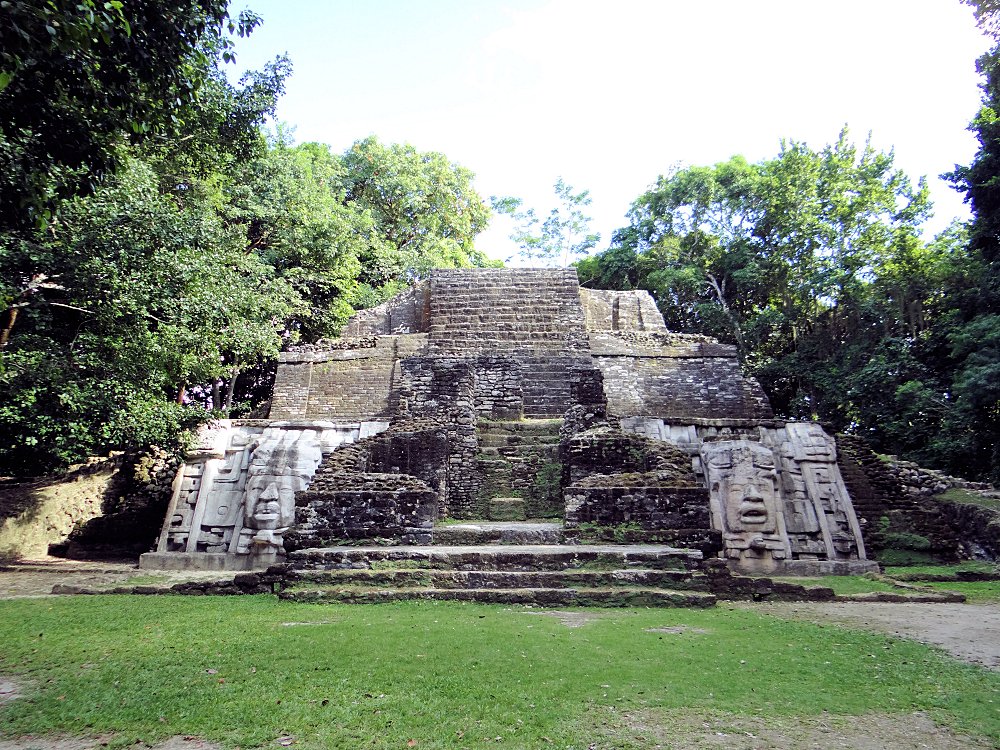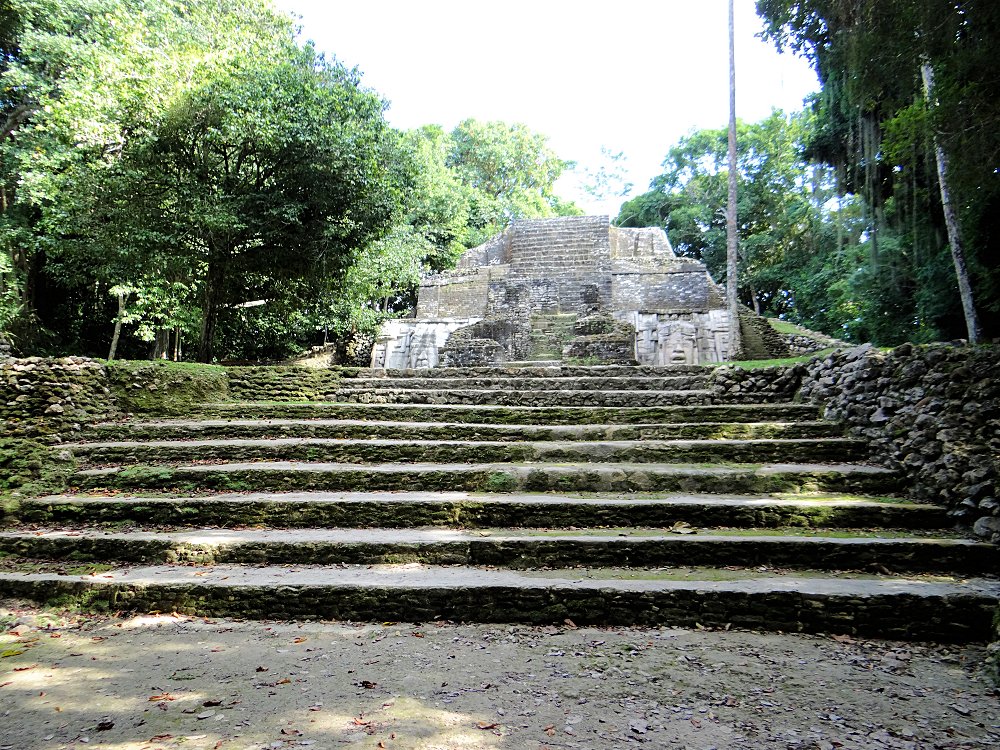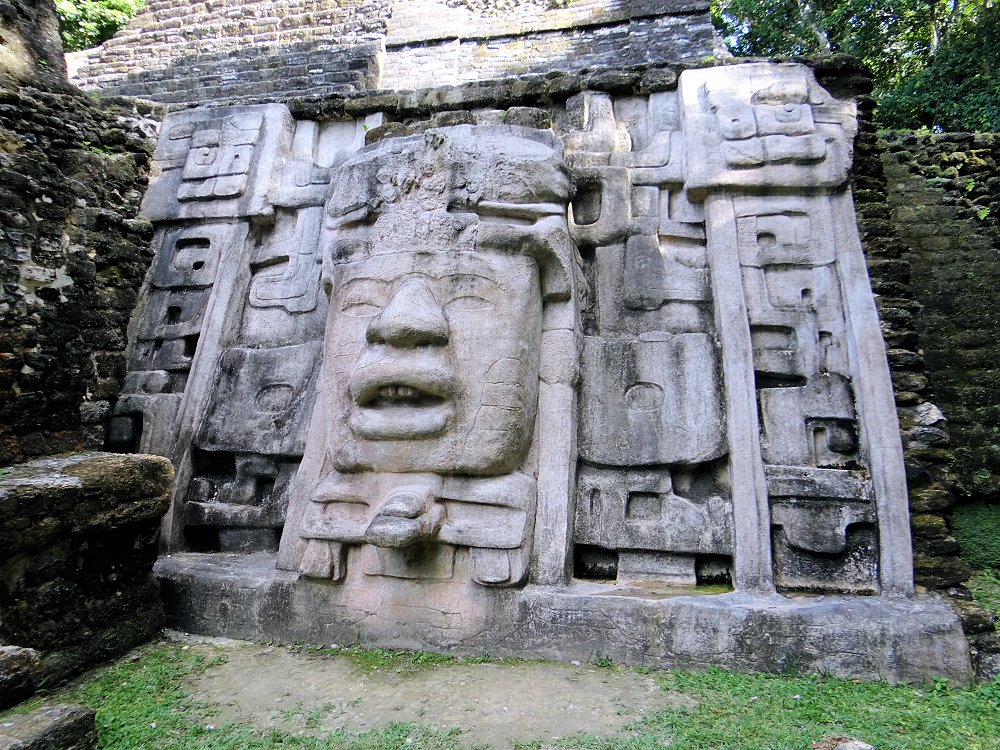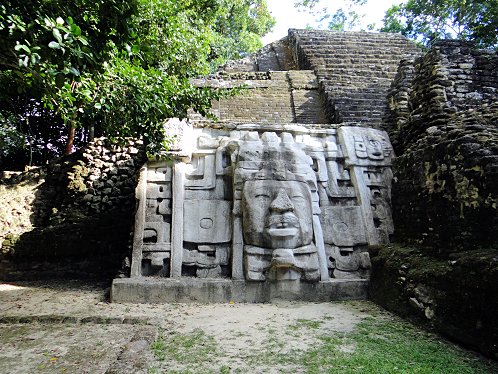Pictures, Photos, Information, Reviews.
Google Map To Lamanai, Belize.
Top Center Of Map - Above "Water Bank."
View Larger Map
We Are Proud Of Our SafeSurf Rating!
Click On Any Of The Following Links By Amazon.Com
For Books Or Videos About Touring In Central America. No Obligation!

Temple Of The Masks. ( Temple / N9-56 ). Lamanai, Belize. 
Temple Of The Masks. ( Temple / N9-56 ). Lamanai, Belize. 
Left Mask At The Temple Of The Masks. ( Temple / N9-56 ). Lamanai, Belize. 
Right Mask At The Temple Of The Masks. ( Temple / N9-56 ). Lamanai, Belize.
 |
| Temple Of The Masks. ( Temple / N9-56 ). Lamanai, Belize. |
|---|
 |
| Temple Of The Masks. ( Temple / N9-56 ). Lamanai, Belize. |
 |
| Left Mask At The Temple Of The Masks. ( Temple / N9-56 ). Lamanai, Belize. |
 |
| Right Mask At The Temple Of The Masks. ( Temple / N9-56 ). Lamanai, Belize. |
We wish to thank Wikipedia, the free encyclopedia for some of the information on this page. We share images and information with Wikipedia. The Mask Temple ( Temple / N9-56 ), is a Maya civilization temple structure at the archaeological site of Lamanai, in the present-day Orange Walk District of Belize. The Mask Temple is the smallest of three excavated pre-Columbian temples. When we were first on the site, a 15 foot tall mask carving was exposed on the right side wall. Then in the spring of 2011, another 13 foot tall mask carving, that had been covered by a stone wall on the left side; was uncovered, revealing an almost identical looking mask. This second mask marks the tradition of symmetry in Mayan architecture. The masks at the Mask Temple are unique in the construction of Mayan Structures, since they are cut from solid blocks of limestone rather than being sculpted from plaster covering a stone core. Each of the masks are adorned with a headdress representing a crocodile. Thus the name of the ruins is Laman'ayin ("submerged crocodile"). It is thought that the facial features of the masks are related to the characteristics of the Olmec iconography as found in ruins of the Gulf Coast of Mexico. In particular the facial characteristics of the upturned lip and broad nose. It is thought that construction began on the Mask Temple in about 200 BC. It is also thought that the temple was modified several times between about 200 BC to AD 1300. Under the temple building is a Preclassic temple with a plaster mask similar to those found at Cerros (ca. 100BC). The temple contains two tombs. One of a man adorned with various shell objects & jade, accompanied by textiles, mats, and some perishable objects. The second tomb, of almost the same date, contained a woman. It is thought that two burials contained a succession of Lamanai's leaders; perhaps a husband and wife, or of a brother and sister. After the main temple had been abandoned, the Maya, living in the southern part of the site,constructed several small low platforms at the temple, to support a new stela. During this time, offerings of pottery figurine incense burners was made at the site.
|
Lamanai is the only Mayan ruin to use its original name. It is interesting that the name contains the name of a Book Of Mormon Lamanite, King; named King Laman. Who, according to Professor of Archaeology, Joseph L. Allen; this ruins could have been named after. (The names, locations, activities of the people, and time period correspond.) The ruins of Lamanai, one of Belize's largest ceremonial centers, are located on the banks of the 30 mile long New River Lagoon in North Central Belize. Lamanai features the second largest Pre-Classic structure in the Maya world and the view across the surrounding forest from the top of the temple is magnificent. Lamanai has been continuously occupied for over 3000 years. Lamanai's remoteness contributed to it's continuous occupation beyond most other Maya sites, until at least 1,650 AD. The Mayan ruins of Lamanai Belize brims with exotic birds and hydrophilic iguanas. There is evidence showing the Mayan life here that dates from about 1500 B.C. through the Postclassic Period (A.D. 950-1544), and Spanish colonial times (A.D. 1544-1700). Lamanai is one of only a few sites whose original Maya name is known - since it translates to "Submerged Crocodile" hence the numerous representations of crocodiles here. The name "Lamanai," appears in 16th and 17th century documents as a Spanish rendering of a Maya name, which we think was originally Laman'ayin ("submerged crocodile"). In front of one temple stands a 13-foot stone temple mask of perhaps a Maya king. The large fa�ade mask certainly represents a human figure, whether this is a depiction of one of Lamanai's ruler or an even higher power is uncertain. There is an abundance of wildlife inside the park surrounding Lamanai. There are at least seven families of howler monkeys that make Lamanai their home and you will most likely see a couple of them peering down through the branches as you wander the trails. In addition, the marshlands around the lagoon supports many species of water birds and wildlife, including crocodiles. Lamanai is spread out along the west bank of the New River Lagoon at a point where the New River flows from the lagoon on its 80-mile journey, north to Chetumal Bay and the Caribbean. The New River, known to the Maya as Dzuluinicob ("foreign men") was one of the arteries used by the conquering Spaniards and missionizing friars as they attempted to penetrate the forests of the Maya lowlands. These photos are when we visited the site with Professor of Archaeology, Joseph L. Allen in November of 2012.
|
It is possible to fly into Belize City and then to go directly to a hotel of your choice and then to take a tour of Lamanai. The Philip S. W. Goldson International Airport (IATA: BZE, ICAO: MZBZ) is the airport that serves Belize's largest city, Belize City. The airport will be going through major expansions to handle more planes and for the airport to bring in flights from Europe. The expansions are planned to be completed in 2015. Philip S. W. Goldson International Airport is about a 30 minutes drive from Belize City's center, in Ladyville. The best way to get to and from the city center is via taxi. Although an airport bus service exists, it is very infrequent and unreliable. If you fly in to Belize City at the Philip S. W. Goldson International Airport, you can be transported to wherever you need to go. You can also arrange air transfer reservations or pre paid tickets from the mainland of Belize to San Pedro, Ambergris Caye and then return back to the mainland of Belize. Tropic Air and Maya Island Air fly to San Pedro, and Ambergris Caye. Note: Lamanai is not the easiest place to reach if you're traveling without a guide. We strongly suggest a guide to get you there and to tour the site. We have links to Priceline.Com on this page so you can arrange you flight and hotels. After confirming your hotel, I suggest contacting their Concierge Services ahead of your arrival, to arrange any tours of the area, all of this can be pre-arranged for you. We do this almost all of the time, when traveling in Belize. It is safe and it works!!! We have never experienced a problem doing it this way!
|
 | |
| Temple Of The Masks. ( Temple / N9-56 ). Lamanai, Belize. | Temple Of The Masks. ( Temple / N9-56 ). Lamanai, Belize. |
|---|---|
 | |
| Left Mask. Temple Of The Masks. ( Temple / N9-56 ). Lamanai, Belize. | Eve DeLange With Left Mask. Temple Of The Masks. ( Temple / N9-56 ). Lamanai, Belize. |
| Right Mask. Temple Of The Masks. ( Temple / N9-56 ). Lamanai, Belize. | Eve DeLange With Right Mask. Temple Of The Masks. ( Temple / N9-56 ). Lamanai, Belize. |
We Are Proud Of Our SafeSurf Rating!
Click On Any Of The Following Links By Amazon.Com
For Books Or Videos About Touring In Central America. No Obligation!
Page One, An Overview.
Page Two, Lamanai Museum.
Page Three, "El Castillo."
Page Four, Plazas 2, 3, 4, Dr. Pendergast.
Page Five, Ball Court, Jaguar Temple.
Travel On The New River.
Back To LDS, Mormon Church History, Home Page
Click Here To View Possible Book Of Mormon Ancient Cities That We Have Visited
Click Here To View A Tour Of The Holy Land (Israel) -With Audrey DeLange
Back To Central America Trips Main Page.
Back To DeLange Home Page.



